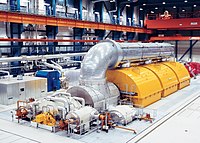
Photo from wikipedia
We previously presented a model for deep penetration of renewables in the electricity sector of the southern half of the United States (Khoie and Yee in Clean Technol Environ Policy… Click to show full abstract
We previously presented a model for deep penetration of renewables in the electricity sector of the southern half of the United States (Khoie and Yee in Clean Technol Environ Policy 17(4):957–971, 2015). In this paper, we present a strategy for the northern half of the United States to utilize its available renewable resources to gradually decrease its reliance on fossil fuels in electricity generation and develop energy portfolios with increasing share of renewables. Using the electricity generation data from the US EIA (Electricity, electric power monthly, 2019d. https://www.eia.gov/electricity/monthly/), and the renewable resource maps produced by NREL (Geospatial data science, 2018a. http://www.nrel.gov/gis/solar.html; Geospatial data science, 2018b. http://www.nrel.gov/gis/wind.html), we develop strategies for the states in the northern half of the USA. We group these states into seven regions: West Coast, Mountain States, Middle West States, Lake States, Mid-Atlantic, South Atlantic, and New England states. For each region, we determine when and if the electricity generation from renewables will meet the region’s electricity need while accounting for a 1% annual increase in electricity demand. The renewable resources included in our models are solar (rural, urban, and rooftop photovoltaic), wind (onshore), hydro, biomass, and geothermal which vary greatly from region to region. We also include nuclear, coal, natural gas, and petroleum. Our results show that the West Coast, Mountain, and Middle West regions have the potential to become 100% renewable in the years 2041, 2039, and 2038, respectively. Additionally, our results show that the four regions of Lake, Mid-Atlantic, South Atlantic, and New England states may not be able to produce 100% of their electricity demand from their renewable resources.
Journal Title: Clean Technologies and Environmental Policy
Year Published: 2019
Link to full text (if available)
Share on Social Media: Sign Up to like & get
recommendations!